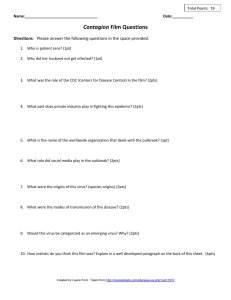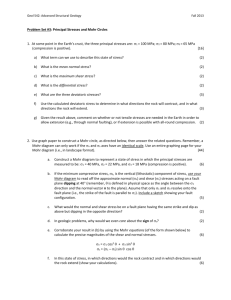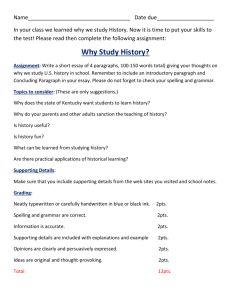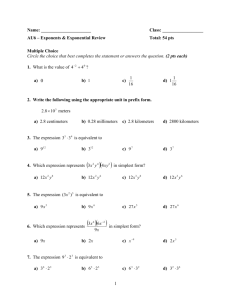Stresses
advertisement
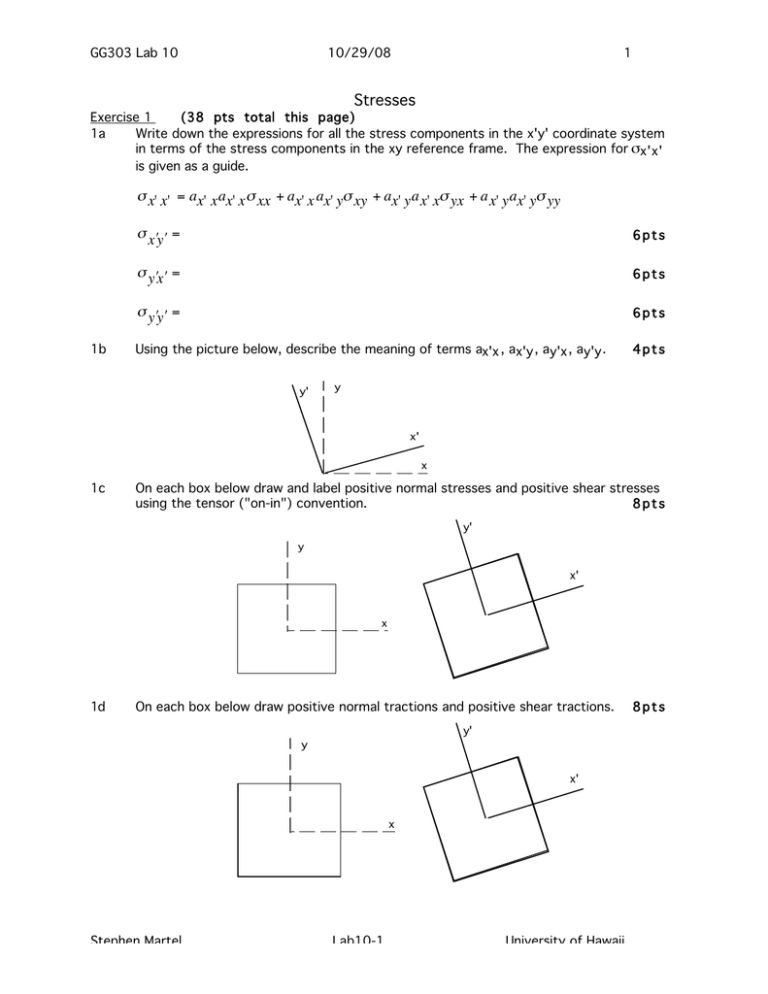
GG303 Lab 10 10/29/08 1 Stresses Exercise 1 (38 pts total this page) 1a Write down the expressions for all the stress components in the x'y' coordinate system in terms of the stress components in the xy reference frame. The expression for σx'x' is given as a guide. σ x' x' = ax' x ax' x σ xx + ax' x ax' yσ xy + ax' y a x' xσ yx + a x' y ax' yσ yy 1b σ x ′y ′ = 6pts σ y ′x ′ = 6pts σ y ′y ′ = 6pts Using the picture below, describe the meaning of terms ax'x , ax'y , ay'x , ay'y . 4pts y' y x' x 1c On each box below draw and label positive normal stresses and positive shear stresses using the tensor ("on-in") convention. 8pts y' y x' x 1d On each box below draw positive normal tractions and positive shear tractions. y' y x' x Stephen Martel Lab10-1 University of Hawaii 8pts GG303 Lab 10 10/29/08 2 Exercise 2: Suppose σx x = -3MPa, σ xy = 8MPa, σyx = 8MPa, σ yy = -15MPa. 2a On a separate piece of paper, draw a square box about 2" on a side showing the stresses with arrows acting on the sides of the square. Show arrows in the positive direction, and label them with the correct magnitudes. Put a north arrow on your box parallel to the y-axis. Make sure the box will be in equilibrium. 2pts 2b On the same piece of paper, draw a new square box about 2" on a side showing the tractions (τxn, τxs, τyn, and τys) with arrows acting on the sides of the square. Remember that the n- and s-directions for a traction are normal and parallel, respectively, to the side of the box the traction acts on. For each side of the box, show arrows in the positive n- and s-directions, and label them with the correct magnitudes. Put a north arrow on your box parallel to the y-axis. 2pts 2c Inside the box draw a line representing a vertical fault that strikes 120°. 2pts 2d Guess whether this fault will tend to slip left-laterally or right-laterally. 2pts 2e Plot a Mohr circle describing this state of stress, labeling the point on the Mohr circle corresponding to the TRACTION COMPONENTS (see 2b) that act on the face that has a normal along the x-axis (i.e., τxn, τxs) and the point on the Mohr circle corresponding to the TRACTION COMPONENTS that act on the face that has a normal along the y-axis (i.e., τ yn , τ ys). 4pts 2f Using the Mohr circle, find the magnitude of τ1 , the most tensile (i.e., most positive) traction, and τ2 , the least tensile (i.e., most negative) traction. 4pts 2g Mark on the Mohr circle the points corresponding to τ 1 and τ2 . 2pts 2h Augment the point marked “τ1 ” with a second label “τx'n', τx's'” while retaining the o r i g i n a l “τ 1 ” label. Augment the point marked “τ2 ” with a second label “τy'n', ty's'” while retaining the original “τ 2 ” label. Use the Mohr circle to find the negative double angles between the x-axis and the x'-axis, and between the x-axis and the y'axis, and label the angles –2θ xx' and –2θxy' , respectively. 4pts 2i On another sheet of paper draw new x, x', y and y' axes in their correct orientation. Then draw a 2" square with sides normal to the x' and y' axes. Then show the principal stresses σx'x' and σy'y' acting on the sides of the square. 4pts 2j Using the angle of (2h) and the formulas on the first page, calculate σx'x', σx'y', σy'x', and σy'y' to check your answer of (2f) – are they consistent? 16pts 2k Inside this square draw a line representing a vertical fault that strikes 120°. 2pts 2l Make a guess as to whether this fault will tend to slip left-laterally or right laterally. Is this guess the same as your first guess? 2pts 2m On one more piece of paper, draw the fault and surround it with a box whose sides are parallel and perpendicular to the fault. Add an x" axis that is parallel to the fault and a y" axis perpendicular to the fault; make sure they are right-handed. 2pts 2n Measure the angle from the x-axis to the y" axis and label it +θ xy" . 2pts 2o Using the corresponding negative double angle, plot on the Mohr circle the point representing (τ y"n" , τy"s"). Label the negative double angle –2θxy" . 4pts 2p Will the fault slip left-laterally or right laterally? How does this compare with (2d) and (2l)? 2pts 2q Use the procedure of (2j) to calculate σy"y" and σy"x" to check your results. 8pts 2r Use the Matlab command “[V,D] = eig” and the stress components at the top of the page to find the principal stresses to check your results (2). Draw a picture showing the principal stresses acting on the sides of a square (2) and the two sets of direction cosines defining the eigenvectors that give the orientation of the two principal stresses (2+2). Include a printout of your Matlab results. 8pts (72 pts total this page) Stephen Martel Lab10-2 University of Hawaii GG303 Lab 10 10/29/08 3 The following page might prove helpful in organizing your work Stress Components (MPa) σxx = τxn = σxy = τxs = σyx = τyn = σyy = τys = Stress Components (MPa) σx’x’ = Traction Components (MPa) τx’n’ = σx’y’ = τx’s’ = σy’x’ = τy’n’ = σy’y’ = τy’s’ = Stress Components (MPa) σx”x” = Traction Components (MPa) τx”n” = σx”y” = τx”s” = σy”x” = τy”n” = σy”y” = τy”s” = Stephen Martel Traction Components (MPa) Lab10-3 University of Hawaii
